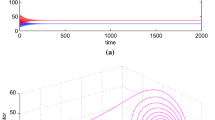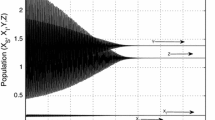Abstract
In this article, a Leslie–Gower Holling type III predator–prey model with disease in predator has been developed from both biological and mathematical point of view. The total population is divided into three classes, namely, prey, susceptible predator and infected predator. The local stability, global stability together with sufficient conditions for persistence of the ecosystem near biologically feasible equilibria have been thoroughly investigated. Boundedness and existence of the system are established. All the important analytical findings have been numerically verified by using program software MATLAB and Maple.








Similar content being viewed by others
References
Atabaigi, A.: Bifurcation and chaos in a discrete time predator–prey system of Leslie type with generalized Holling type III functional response. J. Appl. Anal. Comput. 7(2), 411–426 (2017)
Ali, N., Chakravarty, S.: Stability analysis of a food chain model consisting of two competitive preys and one predator. Nonlinear Dyn. 82(3), 1303–1316 (2015)
Ali, N., Haque, M., Venturino, E., Chakravarty, S.: Dynamics of a three species ratio-dependent food chain model with intra-specific competition within the top predator. Comput. Biol. Med. 85, 63–74 (2017)
Anderson, R.M., May, R.M.: Population Biology of Infectious Disease. Springer, Berlin (1982)
Anderson, R.M., May, R.M.: Infectous Disease of Humans. Dynamics and Control. Oxford University Press, Oxford (1991)
Arqub, O.A.: The reproducing kernel algorithm for handling differential algebraic systems of ordinary differential equations. Math. Methods Appl. Sci. 39(15), 4549–4562 (2016)
Arqub, O.A.: Approximate solutions of DASs with nonclassical boundary conditions using novel reproducing kernel algorithm. Fund. Inform. 146(3), 231–254 (2016)
Arqub, O.A., Rashaideh, H.: The RKHS method for numerical treatment for integrodifferential algebraic systems of temporal two-point BVPs. Neural Comput. Appl. 28, 1–12 (2017)
Aziz-Alaoui, M.A.: Study of a Leslie–Gower-type tritrophic population model. Chaos Solitons Fractals 14(8), 1275–1293 (2002)
Aziz-Alaoui, M.A., Okiye, M.D.: Boundedness and global stability for a predator–prey model with modified Leslie–Gower and Holling type II schemes. Appl. Math. Lett. 16, 1069–1075 (2003)
Banerjee, M., Ghorai, S., Mukherjee, N.: Approximated spiral and target patterns in bazykins prey-predator model: multiscale perturbation analysis. Int. J. Bifurc. Chaos Appl. Sci. Eng. 27(03), 1750038 (2017)
Bildik, N., Deniz, S.: A new efficient method for solving delay differential equations and a comparison with other methods. Eur. Phys. J. Plus 132(1), 51 (2017)
Birkhoff, G., Rota, G.C.: Ordinary Differential Equations. Ginn, Boston (1982)
Chattapadhyay, J., Arino, O.: A predator–prey model with disease in the prey. Nonlinear Anal. 36, 747–766 (1999)
Chattapadhyay, J., Pal, S., Abdllaoui, A.E.I.: Classical predator–prey system with infection of prey population-a mathematical model. Math. Methods Appl. Sci. 26, 1211–1222 (2003)
Deniz, S.: Optimal perturbation iteration method for solving nonlinear heat transfer equations. J. Heat Transf. 139(7), 074503 (2017)
El-Gohary, A., Al-Ruzaiza, A.S.: Chaos and adaptive control in two prey, one predator system with nonlinear feedback. Chaos Solitons Fractals 34(2), 443–453 (2007)
Fatoorehchi, H., Abolghasemi, H.: Investigation of nonlinear problems of heat conduction in tapered cooling fins via symbolic programming. Appl. Appl. Math. 7, 717–734 (2012)
Fatoorehchi, H., Abolghasemi, H.: Improving the differential transform method: a novel technique to obtain the differential transforms of nonlinearities by the Adomian polynomials. Appl. Math. Model. 37(8), 6008–6017 (2013)
Fatoorehchi, H., Zarghami, R., Abolghasemi, H., Rach, R.: Chaos control in the cerium-catalyzed Belousov–Zhabotinsky reaction using recurrence quantification analysis measures. Chaos Solitons Fractals 76, 121–129 (2015)
Freedman, H.I.: A model of predator–prey dynamics modified by the action of a parasite. Math. Biosci. 99, 143–155 (1990)
Gakkhar, S., Naji, R.K.: Existence of chaos in two-prey, one-predator system. Chaos Solitons Fractals 17(4), 639–649 (2003)
Gard, T.C., Hallam, T.G.: Persistece in food web-1 Lotka-Volterra food chains. Bull. Math. Biol. 41, 877–891 (1979)
Ghosh, S., Roy, A., Roy, D.: An adaptation of Adomian decomposition for numeric-analytic integration of strongly nonlinear and chaotic oscillators. Comput. Methods Appl. Mech. Eng. 196(4), 1133–1153 (2007)
Guo, H.J., Song, X.Y.: An impulsive predator–prey system with modified Leslie–Gower and Holling type II schemes. Chaos Solitons Fractals 36, 1320–1331 (2008)
Hadeler, K.P., Freedman, H.I.: Predator–prey populations with parasitic infection. J. Math. Biol. 27(6), 609–631 (1989)
Hale, J.K.: Theory of Functional Differential Equations. Springer, NewYork (1977)
Haque, M., Ali, N., Chakravarty, S.: Study of a tri-trophic prey-dependent food chain model of interacting populations. Math. Biosci. 246(1), 55–71 (2013)
Haque, M., Venturino, E.: Increase of the prey may decrease the healthy predator population in presence of a disease in the predator. Hermis 7(2), 39–60 (2006)
Haque, M., Venturino, E.: An ecoepidemiological model with disease in the predators; the ratio-dependent case. Math. Methods Appl. Sci. 30, 1791–1809 (2007)
Holling, C.S.: The functional response of predators to prey density and its role in mimicry and population regulation. Mem. Entomol. Soc. Can. 97(S45), 5–60 (1965)
Klebanoff, A., Hastings, A.: Chaos in one-predator, two-prey models: cgeneral results from bifurcation theory. Math. Biosci. 122(2), 221–233 (1994)
Korobeinikov, A., Maini, P.K.: Non-linear incidence and stability of infectious disease models. Math. Med. Biol. 22(2), 113–128 (2005)
Li, M.Y., Graef, J.R., Wang, L., Karsai, J.: Global dynamics of a SEIR model with varying total population size. Math. Biosci. 160(2), 191–213 (1999)
Li, X., HU, C., Feng, Z., Li, D: A periodic and diffusive predator–prey model with disease in the prey. Discrete Contin. Dyn. Syst. Ser. S 10(3), 445–461 (2017)
Lin, Y., Jiang, D.: Long-time behavior of a stochastic predator–prey model with modified Leslie–Gower and Holling-type II schemes. Int. J. Biomath. 9(3), 1650039 (2016)
Momani, S., Arqub, O.A., Hayat, T., Al-Sulami, H.: A computational method for solving periodic boundary value problems for integro-differential equations of Fredholm–Volterra type. Appl. Math. Comput. 240, 229–239 (2014)
Murray, J.D.: Mathematical Biology. II Spatial Models and Biomedical Applications. Springer, New York (2001)
Pielou, E.C.: Population and Community Ecology: Principles and Methods. CRC Press, Boca Raton (1974)
Sarwardi, S., Haque, M., Venturino, E.: Global stability and persistence in LG-Holling type II diseased predator ecosystems. J. Biol. Phys. 37(6), 91–106 (2011)
Sharma, S., Samanta, G.P.: A Leslie–Gower predator–prey model with disease in prey incorporating a prey refuge. Chaos Solitons Fractals 70, 69–84 (2015)
Song, X., Li, Y.: Dynamic behaviors of the periodic predator–prey model with modified Leslie–Gower Holling-type II schemes and impulsive effect. Nonlinear Anal. Real World Appl. 9(1), 64–79 (2008)
Venturino, E.: The influence of diseases on Lotka-Volterra systems. Rocky Mt. J. Math. 24, 381–402 (1994)
Venturino, E.: Epidemics in predator–prey models: disease in the predators. IMA J. Math. Appl. Med. Biol. 19, 185–205 (2002)
Xiao, Y., Chen, L.: Modeling and analysis of a predator–prey model with disease in the prey. Math. Biosci. 171(1), 59–82 (2001)
Xu, Y., Liu, M., Yang, Y.: Analysis of a stochastic two-predators one-prey system with modified Leslie–Gower and Holling-type II schemes. J. Appl. Anal. Comput. 7(2), 713–727 (2017)
Yue, Q.: Dynamics of a modified Leslie–Gower predator–prey model with Holling-type II schemes and a prey refuge. Springerplus 5(1), 461 (2016)
Zhuang, K., Jia, G.: The joint effects of diffusion and delay on the stability of a ratio-dependent predator–prey model. Adv. Difference Equ. 2017(1), 44(1-16) (2017)
Zhang, Y., Chen, S., Gao, S., Fan, K., Wang, Q.: A new non-autonomous model for migratory birds with Leslie–Gower Holling-type II schemes and saturation recovery rate. Math. Comput. Simul. 132, 289–306 (2017)
Acknowledgements
The authors convey their sincere thanks and gratitude to all the reviewers for their suggestions towards the improvement of the paper. The second author Mr. Harekrishna Das gratefully acknowledges to ICCR (Indian Council for Cultural Relations), New Delhi [File No. 6-44/2015-16/ISD-II] for awarding scholarship.
Author information
Authors and Affiliations
Corresponding author
Rights and permissions
About this article
Cite this article
Shaikh, A.A., Das, H. & Ali, N. Study of LG-Holling type III predator–prey model with disease in predator. J. Appl. Math. Comput. 58, 235–255 (2018). https://doi.org/10.1007/s12190-017-1142-z
Received:
Published:
Issue Date:
DOI: https://doi.org/10.1007/s12190-017-1142-z




